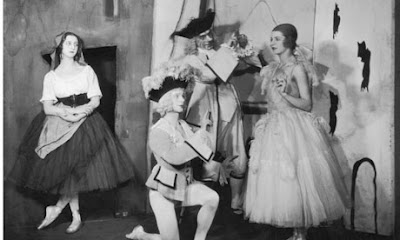
A few days ago I walked up the big steps to the V&A, after weeks of promising myself I would go “this weekend”. Surprisingly there were tickets available for Shadow Catchers and the Diaghilev and the Ballets Russes shows, so I bought tickets to both. With nearly two hours I assumed there would be plenty of time to explore all the work. After an hour however I’d barely finished the first exhibition and rushed to start the Diaghilev, a show touted as a must-see.
Shadow Catchers investigates the mystery and magic of camera-less photography, showing the work of five international artists – Floris Neusűss, Pierre Cordier, Garry Fabian Miller, Susan Derges and Adam Fuss. Each use different processes and techniques to catch shadows for their art. Often this is dependent on light and natural encounters, manipulating what they find to create beautiful and imaginative works.
It is particularly illuminating to watch the film in which each of the artists has about three minutes to describe their work and influences. A great deal of the work on display appears abstract, accidental patterns captured just for a fleeting moment (like a conventional photograph) but with an added fragility – these images are completely original because they are not made from negatives. Neusűss has dedicated his career to extending the practice and study of the photogram. His work often deals with opposites, stark contrasts that focus the attention on form. My favourite artist of the selection was Susan Derges who reveals hidden forces of nature in her work. Derges’ images are mesmerising, but with a natural serenity. I loved her “Vessel No.3” that showed the tiniest adorable little frogs amidst a wonderful stillness.
Diaghilev is an epic show that you need at least an hour and a half to look round. Serge Pavolovich Diaghilev (1872-1929) was regarded as many things: dictator, devil, sorcerer, charmer, but above all he was a lover of art, music and dance. Through much dedication and driving ambition he created the radical dance company – the Ballet Russes, a groundbreaking troupe that pushed the boundaries in a such a way that their work continues to influence cultural activity today.
As an individual, Diaghilev remains elusive but through his work with Ballet Russes we slowly discover more about the man and his life. I was struck by the detail the V&A have gone to, exploring every facet of the ballet company and surrounding art and music that you soon realise are vital to its success. I adore costumes and was thrilled to see the outrageous dancing outfits displayed throughout the show. How they danced in such heavy ornate clothes is astounding, and there are clips of film to show the original performances alongside the decorative costumes.
Music is a big part of this exhibition, Diaghilev chose unexpected contemporary music for his ballets, more than half of which he commissioned himself. Satie, Poulenc and Stravinsky all wrote for Diaghilev and his dancers. Erik Satie said about the great man “Diaghilev’s a likeable man, but awful”. Stravinsky rose in fame through association with Diaghilev, both representing the Russian national style. In 1913 Diaghilev’s company performed Stravinsky’s specially commissioned ‘The Rite of Spring’, a particularly disorientating piece of music. It was a revolutionary statement that made others notice this shocking masterpiece, and since then over 200 versions of 'The Rite of Spring’ have been choreographed.
There were five main choreographers for the Ballet Russes, including Diaghilev’s lover Vaslav Nijinsky who was an utterly brilliant lead in many of their productions. All the choreographers were adapting or rejecting traditional ballet to create a new original style of dance that was constantly evolving.
For the sets, Diaghilev had the best up and coming artists on board. And often he would enlist the help of his friends, such as Coco Chanel, to help find potential patrons to help with the insanely large production costs. The influence of Cubism was vital to Diaghilev’s later shows. The bold forms and theatricality of the Ballet Russes suited the Cubist and Art Deco aesthetic perfectly. An amazing enormous cloth hangs in the V&A, an enlarged version of a tiny Picasso painting.
When he died in 1929, Diaghilev left behind an astonishing legacy of music, dance and art. The V&A explores every aspect of this legacy in a stunning show that will surely be remembered as one of the great exhibitions of 2010.
Diaghilev continues until 9 January 2011, Shadow Catchers until 20 February 2011, visit V&A website here.
No comments:
Post a Comment